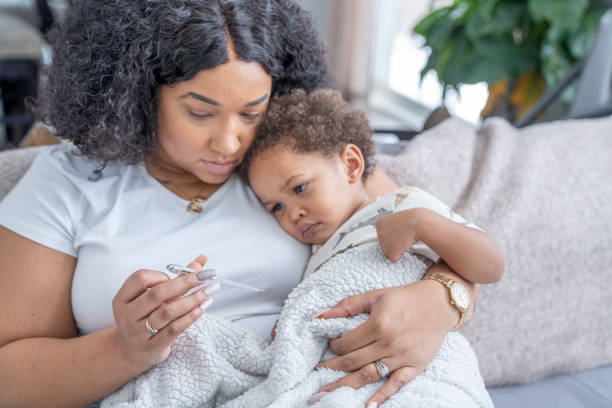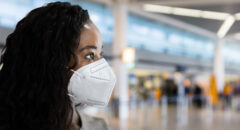
Children under 5 years old infected with the Omicron variant of COVID-19 are now experiencing a unique symptom. Pediatricians across the country say they are seeing a spike in croup cases.
"We were seeing more patients with croup, and more patients were testing positive for COVID, which was something that we had not observed during earlier phases of previous surges with COVID," Dr. Ashley Keilman, a specialist in pediatric emergency medicine at Seattle Children's Hospital says.
What is croup?
Croup is often brought on by parainfluenza respiratory viruses. It typically occurs when the upper airways become inflamed and can make breathing challenging. It is more common among kids because they have smaller airways than adults.
This inflammation in the voicebox, the windpipe and the bronchial tubes causes the child to have a loud distinctive cough that resembles a barking seal, according to CNN. If a child with croup tries to breathe, he or she may also produce a high-pitched whistle known as stridor.
Symptoms can clear up after about five days. However, for other kids, the symptoms don't go away with home treatments.
The American Academy of Pediatrics suggests calling a doctor if your child has these symptoms:
- A whistling sound that gets louder with each breath.
- Inability to breathe or speak easily.
- Bluish lips or fingernails.
- Drooling.
- Difficulty swallowing saliva.
Parents: What You Need to Know About Kids & COVID-19
A spike in croup cases
According to Eric Ball, MD, a pediatrician at Children's Health Orange County in Southern California COVID-19 cases started to spike in his young patients just before Christmas. While his older, vaccinated patients come in with mild symptoms, children under 5 appear to be more seriously affected by the disease.
"Croup is one of many things that we are seeing these kids present with," Ball tells MedPage Today. "But, as a general rule, the people who have not had vaccines, which largely are the little children, are getting sicker than the people who have been vaccinated and have some protection against COVID."
In the first weeks of 2022, Ball has admitted more children to the hospital for COVID-19 than he did for all of 2021.
"Omicron has proven itself to be an upper respiratory illness and an illness in the upper airway rather than the lower airways in the lungs and so, therefore, people are sort of blowing it off as a just a cold virus and no big deal. But I think what we're seeing is that of the upper respiratory sort of infections, viral infections, croup is among the most severe and puts children in the ICU regularly," says study co-author Dr. Indi Trehan, attending physician in infectious disease and virology and emergency medicine at Seattle Children's.
"You know, as any parent will tell you, it's one of the scariest things to see your child not be able to breathe from it," Trehan adds. "So this early signal of high rates of croup with Omicron is pretty concerning. We're trying to get this word out to our colleagues."
Doctors all over the country are seeing similar trends.
A preliminary study found that 2.4% of kids 13 and younger who were hospitalized in one area of South Africa for COVID-19 caused by Omicron also had a croup diagnosis.
There have also been more opportunities for croup to develop with this surge because so many kids have had COVID-19. Nearly 4.2 million COVID-19 cases have been reported in U.S. children since the beginning of January, according to the American Academy of Pediatrics.
Dr. Claudia Hoyen, a pediatric infectious disease specialist at UH Rainbow Babies and Children's Hospital in Cleveland, usually sees croup season in her area typically hit in the fall. This caused her to raise an eyebrow at the high number of kids that started to show up with croup in December, during the Omicron wave.
"We know that your nasal tissues are much more receptive to Omicron, and the lung is not," Hoyen shares. "We've not seen croup with other surges. This one has been different,"
The good news, however is that most kids with croup haven't needed to be admitted to the hospital. If they come in for treatment, doctors typically give them a corticosteroid that can reduce the inflammation in the respiratory tract, CNN notes.
Of course the best result would be if young children could escape contracting COVID at all. For young children that are unable to get vaccinated, Hoyen suggests making sure everyone around them is fully vaccinated, if possible.
"Do what you can to save the little ones from being a barky seal. It's really distressing to hear them, trust me, and it can be quite serious," Hoyen says. "So do what you can to help them. Getting yourself vaccinated is easy and important."
RELATED: Pfizer Asks FDA to Approve Its Vaccine for Children Under 5
What to do if your child gets infected
If your child gets infected, doctors suggest:
-
Make them as comfortable as possible.
-
Give them medication to suppress a fever if they have one.
-
If they can’t breathe, go see a doctor.
-
Keep them as calm as you can.
Tips for comforting a child with croup
The American Academy of Family Physicians mentions these tips for parents of a croupy child:
- Don't give cough medicine to a child under 4 years old. But you can offer Tylenol to help ease pain. Never give a child aspirin.
- Run a humidifier in your child's room.
- Place a warm, wet washcloth over your child's nose. Ask the child to breathe through the cloth.
- Sit with your child for about 10 minutes inside a warm, steamy bathroom outside the shower. The shower should be running hot.








